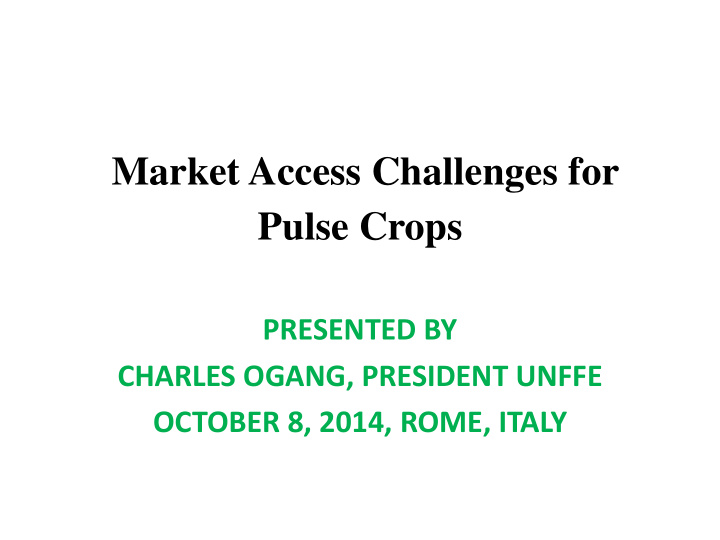



Market Access Challenges for Pulse Crops PRESENTED BY CHARLES OGANG, PRESIDENT UNFFE OCTOBER 8, 2014, ROME, ITALY
Presentation outline • Introduction • Production patterns and trade • Market access challenges • Conclusion
Introduction • Pulse crops are the edible dry mature seeds of leguminous crops. They often exclude those harvested for fresh products such as the French beans which are classified as vegetables. • Pulse crops include the common beans (Kidney beans, black beans, white haricot beans etc.), pigeon peas, field peas, green and black grams, chickpeas, lentils, cow peas and Bambara groundnuts. • In the developing countries, pulse crops are planted on marginal land and grown under rain-fed conditions, which explain their low yields and large year-to-year production variability • Many smallholder farmers interplant pulses with major crops while others use them as cover crops in perennials such as bananas, coffee and cassava.
Introduction Cont… • Pulses are often regarded as low value crops • But they provide protein for majority of the populations in the developing countries • Some pulses are for human consumption while others especially dry peas are used as feedstuff.
Production Patterns and trade • The major producers of pulses include Canada, Australia, Myanmar, China and the United States • Majority of the developing countries produce mainly for home consumption. • The largest market for food pulses is South Asia (mainly Bangladesh, India, Pakistan and Sri Lanka), while the largest market for feed pulses is the European Union.
Production patterns and trade cont.… • For market composition, dry peas are the largest traded pulse with a 37 percent share of the total pulse trade, followed by dry beans (28 percent), lentils (9 percent) and chickpeas (8 percent).( Source: FAOSTAT)
Market Access Challenges • Like majority of agricultural commodities pulses are subjected to Non-Tariff Barriers to Trade (NTBs), Technical Barriers to Trade (TBTs) and Sanitary and Phytosanitary (SPS) measures. • Other market access challenges occur at farm household level where farmers find a lot of challenges delivering their produce to the local market because of poor rural road infrastructure.
Poor infrastructure- Pictorial
Challenges Cont…. • At national level, marketing of pulses is still not well organized and traders find it challenging to get adequate quantities of the right quality. • Majority of the pulses, particularly beans are mixed colour and this limits market access. • Another challenge at the traders’ level is inappropriate storage facilities which result into the pulses being infested with pests. This will definitely pose a market access problem in terms of the standards.
Challenges Cont… • At the regional level challenges such None Tariff Barriers arise whereby the traders may lack the required standards of the pulses as well as the necessary documentation to enable them market the pulses in another country. • At international level challenges such as Sanitary and Phytosanitary requirements as well as Technical Barriers to Trade arise. This is mainly because the pulses produced in the developing countries can hardly meet the standards requirements by the developed nations. • Further, developing countries face the challenge of the supply side whereby they may not meet the demand or quotas set by the importing countries.
Conclusion • Trade barriers/ market access limitations hamper normal trade among nations. Indirectly the costs are normally borne by the different actors along the value chain i.e. farmers, processors, traders and consumers. This calls for greater efficiencies in the entire trading system in order to equitably spread the benefits along the value chain. • Governments and international bodies should, therefore, work to improve the regulatory framework in which trade occurs to enhance food security, reduce price volatility and enhance the return to growers/farmers.
Farming is Honourable and Dignifying! Thank you very much for your kind attention!
Recommend
More recommend